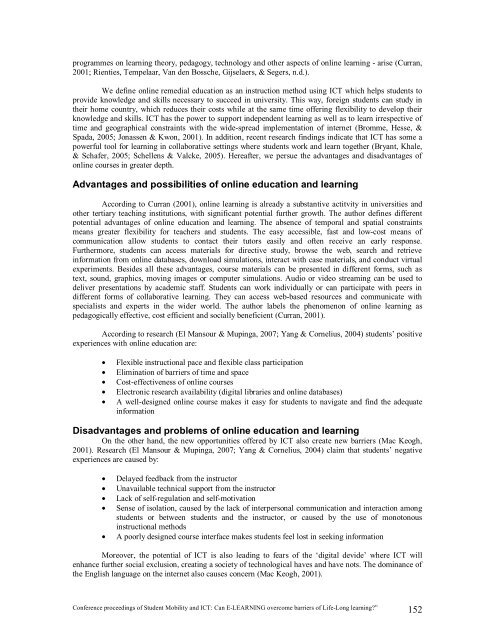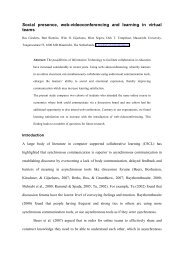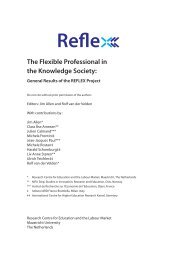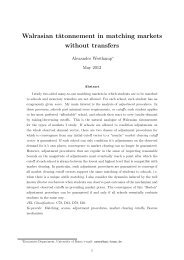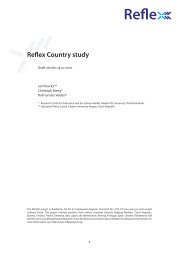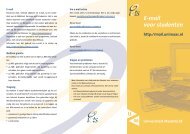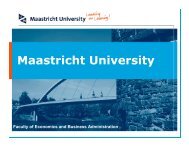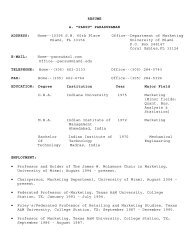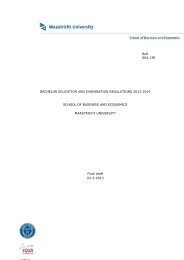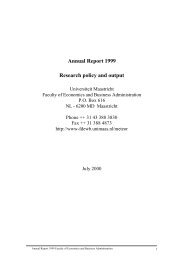proceedings of Student Mobility and ICT: Can E-LEARNING
proceedings of Student Mobility and ICT: Can E-LEARNING
proceedings of Student Mobility and ICT: Can E-LEARNING
Create successful ePaper yourself
Turn your PDF publications into a flip-book with our unique Google optimized e-Paper software.
programmes on learning theory, pedagogy, technology <strong>and</strong> other aspects <strong>of</strong> online learning - arise (Curran,<br />
2001; Rienties, Tempelaar, Van den Bossche, Gijselaers, & Segers, n.d.).<br />
We define online remedial education as an instruction method using <strong>ICT</strong> which helps students to<br />
provide knowledge <strong>and</strong> skills necessary to succeed in university. This way, foreign students can study in<br />
their home country, which reduces their costs while at the same time <strong>of</strong>fering flexibility to develop their<br />
knowledge <strong>and</strong> skills. <strong>ICT</strong> has the power to support independent learning as well as to learn irrespective <strong>of</strong><br />
time <strong>and</strong> geographical constraints with the wide-spread implementation <strong>of</strong> internet (Bromme, Hesse, &<br />
Spada, 2005; Jonassen & Kwon, 2001). In addition, recent research findings indicate that <strong>ICT</strong> has some a<br />
powerful tool for learning in collaborative settings where students work <strong>and</strong> learn together (Bryant, Khale,<br />
& Schafer, 2005; Schellens & Valcke, 2005). Hereafter, we persue the advantages <strong>and</strong> disadvantages <strong>of</strong><br />
online courses in greater depth.<br />
Advantages <strong>and</strong> possibilities <strong>of</strong> online education <strong>and</strong> learning<br />
According to Curran (2001), online learning is already a substantive actitvity in universities <strong>and</strong><br />
other tertiary teaching institutions, with significant potential further growth. The author defines different<br />
potential advantages <strong>of</strong> online education <strong>and</strong> learning. The absence <strong>of</strong> temporal <strong>and</strong> spatial constraints<br />
means greater flexibility for teachers <strong>and</strong> students. The easy accessible, fast <strong>and</strong> low-cost means <strong>of</strong><br />
communication allow students to contact their tutors easily <strong>and</strong> <strong>of</strong>ten receive an early response.<br />
Furthermore, students can access materials for directive study, browse the web, search <strong>and</strong> retrieve<br />
information from online databases, download simulations, interact with case materials, <strong>and</strong> conduct virtual<br />
experiments. Besides all these advantages, course materials can be presented in different forms, such as<br />
text, sound, graphics, moving images or computer simulations. Audio or video streaming can be used to<br />
deliver presentations by academic staff. <strong>Student</strong>s can work individually or can participate with peers in<br />
different forms <strong>of</strong> collaborative learning. They can access web-based resources <strong>and</strong> communicate with<br />
specialists <strong>and</strong> experts in the wider world. The author labels the phenomenon <strong>of</strong> online learning as<br />
pedagogically effective, cost efficient <strong>and</strong> socially beneficient (Curran, 2001).<br />
According to research (El Mansour & Mupinga, 2007; Yang & Cornelius, 2004) students’ positive<br />
experiences with online education are:<br />
• Flexible instructional pace <strong>and</strong> flexible class participation<br />
• Elimination <strong>of</strong> barriers <strong>of</strong> time <strong>and</strong> space<br />
• Cost-effectiveness <strong>of</strong> online courses<br />
• Electronic research availability (digital libraries <strong>and</strong> online databases)<br />
• A well-designed online course makes it easy for students to navigate <strong>and</strong> find the adequate<br />
information<br />
Disadvantages <strong>and</strong> problems <strong>of</strong> online education <strong>and</strong> learning<br />
On the other h<strong>and</strong>, the new opportunities <strong>of</strong>fered by <strong>ICT</strong> also create new barriers (Mac Keogh,<br />
2001). Research (El Mansour & Mupinga, 2007; Yang & Cornelius, 2004) claim that students’ negative<br />
experiences are caused by:<br />
• Delayed feedback from the instructor<br />
• Unavailable technical support from the instructor<br />
• Lack <strong>of</strong> self-regulation <strong>and</strong> self-motivation<br />
• Sense <strong>of</strong> isolation, caused by the lack <strong>of</strong> interpersonal communication <strong>and</strong> interaction among<br />
students or between students <strong>and</strong> the instructor, or caused by the use <strong>of</strong> monotonous<br />
instructional methods<br />
• A poorly designed course interface makes students feel lost in seeking information<br />
Moreover, the potential <strong>of</strong> <strong>ICT</strong> is also leading to fears <strong>of</strong> the ‘digital devide’ where <strong>ICT</strong> will<br />
enhance further social exclusion, creating a society <strong>of</strong> technological haves <strong>and</strong> have nots. The dominance <strong>of</strong><br />
the English language on the internet also causes concern (Mac Keogh, 2001).<br />
Conference <strong>proceedings</strong> <strong>of</strong> <strong>Student</strong> <strong>Mobility</strong> <strong>and</strong> <strong>ICT</strong>: <strong>Can</strong> E-<strong>LEARNING</strong> overcome barriers <strong>of</strong> Life-Long learning?” 152


